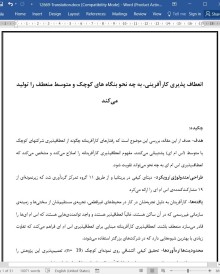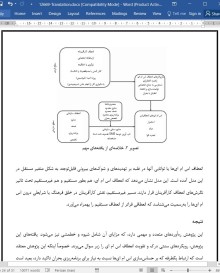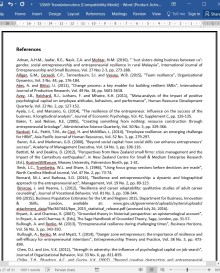
دانلود مقاله چگونگی ایجاد بنگاه های کوچک و متوسط منعطف با انعطاف پذیری کارآفرینی
چکیده:
هدف- هدف از این مقاله، بررسی این موضوع است که رفتارهای کارآفرینانه چگونه از انعطافپذیری شرکتهای کوچک یا متوسط (اس ام ای) پشتیبانی میکنند، مفهوم انعطافپذیری کارآفرینانه را اصلاح میکند و مشخص میکند که انعطافپذیری اس ام ای به چه نحو میتواند تقویت شود.
طراحی/متدولوژی/رویکرد- دیتای کیفی در بریتانیا و از طریق 11 گروه تمرکز گردآوری شد که زیرنمونهای از 19 مشارکتکنندهی اس ام ای را ارائه میکرد
یافتهها- کارآفرینان به دلیل تجربهشان در کار در محیطهای غیرقطعی، تجربهی مستقیمشان از سختیها و زمینهی سازمانی غیررسمی که در آن ساکن هستند، غالباً انعطافپذیر هستند و واجد توانمندیهایی هستند که اس ام ایها را قادر میسازد منعطف باشند. انعطافپذیری کارآفرینانه مبنایی برای انعطافپذیری اس ام ای فراهم میکند که تفاوت زیادی با بهترین شیوههایی دارد که در شرکتهای بزرگتر استفاده میشوند.
محدودیتها/رهآوردها- تحقیق کیفی اکتشافی روی نمونهای کوچک (n= 19)، تعمیمپذیری این پژوهش را محدود ساخته است. تحقیق بیشتر میتواند بلحاظ کمّی، یافتههای این مقاله را بیازماید و/یا به بررسی پیوند بین انعطافپذیری کارآفرینانه و انعطافپذیری شرکتهای بزرگتر بپردازد.
رهآوردهای عملی- خطمشی و شیوههایی که به منظور تقویت انعطافپذیری اس ام ایها طراحی شدهاند، باید بهجای تشویق به برنامهریزی رسمی، توجه بیشتری به ایجاد ظرفیت به منظور فائق آمدن بر عدمقطعیت نمایند، روابط شخصی را ایجاد و تقویت کنند و توانایی آزمایش و تفکر خلاقانه در پاسخ به بحرانها را فعال نمایند.
اصالت/ارزش- این مقاله از یک تحقیق روانشناسی استفاده میکند تا درک و شناختی را که از انعطافپذیری کارآفرینانه وجود دارد، اصلاح کند و بصورت تجربی، روابط بین انعطاپذیری کارآفرینانه و انعطافپذیری اس ام ای را بررسی و بصورت قیاسی آن را تئوریزه کند.
مقدمه
عمدتاً باور بر این است که شرکتهای کوچک و متوسط، فاقد انعطاف هستند و بهنحوی نامتناسب تحت تأثیر طیف گستردهای از شوکهای بیرونی قرار دارند (باتیستی و دیکینز 2012؛ اینگیریج و همکاران 2008). با توجه به اهمیت اقتصادی و اجتماعی اس ام ایها و مقیاس و تنوع اخیرِ رویدادهای دشوار، این خصیصه نگرانکننده است. وضعیت آب و هوایی نامساعد، حملات تروریسی، باجافزارها، بیماریهای همهگیر جهانی و بیثباتی جغرافیایی-سیاسی، چالشهای مهمی را پیش روی ساختار اس ام ای، موفقیت و بقای آن قرار میدهند (لیننلوئک و همکاران 2012؛ مای و کاسکی 2013). تصور میشود که توانایی اس ام ایها برای نمایش انعطافپذیری خود- ظرفیت بازگشت از شرایط سخت، مناقشات و ناکامیها- به دلیل فقدان برنامهریزی برای بحرانها (پاتون و همکاران 2010)، منابع محدود داخلی، پایگاه مشتریان ضعیف و توان چانهزنیِ پایین (اسمالبون و همکاران، 2012)، کاهش یافته باشد.
اما شواهد تجربی اخیر حاکی از انعطافپذیری قابلتوجه میان اس ام ایها در بافت رویدادهای دشوار بودهاند. مثلاً پس از وقوع زلزلهی کرایستچرچ در سال 2010، باتیسی و دیکینس (2012) متذکر شدند که فقدان طرحهای مدیریت بحران مکتوب، انعطافپذیری در اس ام ایها را تضعیف نکرده است. آنها این یافتهی دور از ذهن را اینگونه شرح میدهند که «اس ام ایها انعطافپذیرترند و بهتر قادر به پاسخ سریع به محیطهای درحالتغییر هستند. ظرفیت انطباقپذیر، جهت بهبود انعطافپذیری در مقابل بحرانهایی نظیر فجایع طبیعی، اهمیت دارند». گراهام (2007) نیز شواهدی یافت مبنی بر اینکه پس از حملات تروریسی یازدهم سپتامبر در آمریکا، یک «پاسخ مشترک میان صاحبان بیزنسهای کوچک نسبت به حملات تروریسی، تعهد به منهتنِ جنوبی را بهمنزلهی مکانی برای انجام کسبوکار، تجدید کرد». این نشان میدهد که برخی از اس ام ایها میتوانند «انعطاف اساسی» از خود بروز دهند.
تقابل بین پنداشت ادراکشده و شواهد تجربی جدید در رابطه با انعطاف اس ام ای، حاکی از این است که نیاز به مطالعهی بیشتر در خصوص نحوه دستیابی اس ام ایها به انعطاف و نقش کارآفرینان در این فرایندها، وجود دارد. انعطاف کارآفرینانه را اینگونه تعریف میکنند «شکلی از توانایی عاطفی و شناختی که برای کارآفرین مفید است، خصوصاً وقتی که پس از ناکامیهای مرتبط با ابتکارات کارآفرینانهشان، مجدد به حالت اول بازمیگردند و بهبود مییابند». کانتور و ایسریسای (2012)، معتقدند که رابطهای مهم اما نامشخص بین «فعالیتهای کارآفرینانه و راهبردهای انعطاف» وجود دارد که نشان میدهد تحقیق بیشتر برای بررسی رابطه بین رفتار کارآفرینانه و انعطاف اس ام ای، مفید خواهد بود. کارآفرینان خصایص متعددی را از خود بروز میدهند که به انعطاف مرتبطند، مثلاً در مواجهه با ابهام و تغییر، خود را توانمند نشان میدهند، فرصتهایی که قبلاً استفاده نشدهاند را شناسایی میکنند، «شرایط نامساعد» را بهمنزلهی فرصت تلقی میکمنند، در زمانهای دشواری مقاومت و پایداری از خود نشان میدهند و ابتکارات پیشگیرانهای از خود بروز میدهند. اما علیرغم اهمیت نظری و عملی این موضوع، توجه اندکی در متون پژوهشی به آن شده است. تمرکز بر تبیین نظری و تجربی نقش انعطاف کارآفرینانه در تقویت انعظاف اس ام ای، مفید است زیرا رفتارها و نگرشهای شخصی کارآفرینان، تاثیر مستقیم زیادی بر ساختار اس ام ای، راهبرد و عملکرد آن دارند. علاوه بر این، تمرکز بر انعطاف کارآفرینانه و انعطاف اس ام ای، حائز اهمیت است زیرا اکثر تحقیقات مرتبط با انعطاف، بر شرکتهای بزرگ و خصایص آنها تمرکز دارند.
نتیجه
این پژوهش رهآوردهای متعدد و مهمی دارد، که مزایای آن شامل شیوه و خطمشی نیز میشود. یافتههای این پژوهش، رویکردهای سنتی درک و تقویت انعطاف اس ام ای را زیر سوال میبرند. خصوصاً اینکه این پژوهش معتقد است که ارتباط یکطرفه که بر حساسسازی اس ام ایها نسبت به نیاز برای برنامهریزی بحران تاکید دارد، بعید است بتواند اس ام ایهای انعطافپذیر را تقویت کند. در عوض، این پژوهش به راهبردهای جایگزین متعددی معتقد است.
این مدل که بصورت تصویر 2 ارائه شده است، بیانگر این است که هم خصایص انعطاف کارآفرینانه و هم خصایص انعطاف فردی، هر دو مستقیم و غیرمستقیم در انعطاف اس ام ای سهیمند. به این ترتیب، طرحهایی که انعطاف فردیِ کارآفرینان یا رویکردهای کارآفرینی را برای کسبوکارهای کوچک تبلیغ میکنند، میتوانند تاثیری بر انعطاف اس ام ای داشته باشند. بعلاوه، شواهد نشان میدهند که سیاستگذاران باید دیدگاهی دقیقتر درباره معنای انعطاف در بافت کارآفرینانه داشته باشند و رهآوردهایی را که این برای پشتیبانی از اس ام ایها دارد، مدنظر قرار دهند. نویسندگان این تفسیر را پیشنهاد میدهند زیرا کارآفرینان در این پژوهش، با انعطاف کارآفرینانه بهمراه بقای یک بیزنس واحد، برابری نکردند. بلکه فرصتهای تجدید قوا و نوآوری را بهمنزله مولفهای تلقی کردند که به اندازه انعطاف اهمیت دارد. این یافتهها سه مداخله مهم را پیشنهاد میدهد که دولت یا شبکههای اس ام ای میتوانند در جهت تقویت انعطاف کارآفرینانه از آن استفاده کنند:
1) معرفی دستورالعمل و/یا مقرراتی که دسترسی مستمر اس ام ایها را به منابع جایگزین انعطاف، بهرسمیت بشناسد
2) رویدادهای اس ام ای محلی که بطور غیرمستقیم «ارتباط اجتماعی» را شکل میدهند (یک منبع انعطاف فردی مهم)
3) پشتیبانی از کارآفرینان در تعیین این موضوع که به چه نحوی میتوانند درون سازمان خودشان، از طریق مشاوره، نه دستورالعمل و مقررات، بهتر به انعطاف پرداخت و به این ترتیب عوامل حفاظتی را از طریق کنترل افزایش داد.
Abstract
Purpose – The purpose of this paper is to investigate how entrepreneurial behaviors support small and medium-sized enterprise (SME) resilience, refine the concept of entrepreneurial resilience, and identify how SME resilience might be promoted.
Design/methodology/approach – Qualitative data were collected in the UK via 11 focus groups which provided a sub-sample of 19 SME participants.
Findings – Because of their experience operating in uncertain environments, their direct experience of adversity, and the informal organizational settings they inhabit, entrepreneurs are often highly resilient and possess capabilities that enable SMEs to be resilient. Entrepreneurial resilience provides a basis for SME resilience that differs significantly from best practices as understood in larger firms.
Research limitations/implications – Exploratory qualitative research on a small sample (n ¼ 19) limits the generalizability of this work. Further research could quantitatively test the paper’s findings and/or examine the link between entrepreneurial resilience and the resilience of larger firms.
Practical implications – Rather than encouraging formal planning and redundancy, policy and practice designed to promote the resilience of SMEs should pay greater attention to building capacities to cope with uncertainty, generating and leveraging personal relationships, and activating the ability to experiment and think creatively in response to crises.
Originality/value – This paper draws on organizational psychology research to refine understanding of entrepreneurial resilience and to empirically examine and inductively theorize the multi-level relationships between entrepreneurial resilience and SME resilience.
Introduction
It is widely believed that small and medium-sized enterprises (SMEs) lack resilience and that they are disproportionately impacted by a wide range of external shocks (Battisti and Deakins, 2012; Ingirige et al., 2008). This characteristic is worrying, given the social and economic significance of SMEs (Ates and Bititci, 2011; de Vries and Shields, 2006; Lewis and Cassells, 2010) and the recent scale and diversity of extreme events. Severe weather, terrorist attacks, ransomware, global pandemics, and geo-political instability create significant challenges to SME structure, success, and survival (Linnenluecke et al., 2012; May and Koski, 2013). It is thought that the ability of SMEs to exhibit resilience – the capacity to “rebound or bounce back from adversity, conflict, and failure” (Luthans, 2002, p. 702) – is reduced because of a lack of planning for crises (Paton et al., 2010), limited internal resources, narrow customer base, and low bargaining power (Smallbone et al., 2012).
However, recent empirical evidence has demonstrated significant resilience among SMEs in the context of extreme events. For example, in the aftermath of the 2010 Christchurch earthquakes, Battisti and Deakins (2012) noted that the absence of written crisis management plans did not undermine resilience in SMEs. They explained this possibly counter-intuitive finding by observing that, “[…] they [SMEs] are more flexible and better able to respond quickly to changing environments. This adaptive capability is crucial to improve resilience to crises such as natural disaster” (Battisti and Deakins, 2012, p. 6). Graham (2007, p. 304) also found evidence suggesting that after the 9/11 terrorist attack in the USA, a “common response among [small] business owners to the terrorist attack was a renewed commitment to Lower Manhattan as a place to do business.” This suggests that some SMEs can demonstrate “underlying resilience” (Smallbone et al., 2012, p. 1).
The contrast between the received wisdom and recent empirical evidence in relation to SME resilience suggests the need for greater study of how SMEs achieve resilience and of the role of entrepreneurs in these processes. Entrepreneurial resilience is defined as, “as a form of emotional and cognitive ability that is useful for the entrepreneur, particularly when bouncing back after failures connected to their entrepreneurial initiative” (Bernard and Barbosa, 2016, p. 89). Kantur and İşeri-Say (2012, p. 772) argue that there is an important, but unspecified, relationship between “entrepreneurial activities and resilience strategies,” suggesting that additional research examining links between entrepreneurial behavior and SME resilience is likely to be fruitful. Entrepreneurs exhibit many of the characteristics commonly associated with resilience, as they tend to excel in the face of ambiguity and change (Ayala and Manzano, 2014), identify previously unexploited opportunities (Hitt et al., 2001), view “dire circumstances” as opportunity (Bullough and Renko, 2013, p. 345; Bullough et al., 2014), persist during times of adversity (Holland and Shepherd, 2013), and proactively take initiative (Krueger and Brazeal, 1994). However, despite the theoretical and practical significance of this topic, it has received remarkably little attention in the literature (Bullough et al., 2014; Powell and Baker, 2011). A focus on theoretically and empirically exploring the role of entrepreneurial resilience in promoting SME resilience is likely to be productive because the behaviors and personality attributes of entrepreneurs have been found to have a strong direct impact on SME structure, strategy, and performance (Miller, 1983; Miller and Toulouse, 1986). Additionally, a focus on entrepreneurial resilience and SME resilience is important because much of the research on resilience focuses on large firms and their characteristics (e.g. Sullivan-Taylor and Wilson, 2009).
Conclusions
There are several significant implications of this study, with benefits reaching practice and policy. Findings draw into question traditional approaches to understanding and promoting SME resilience. Specifically, this research suggests that one-way communication, which emphasizes the sensitization of SMEs to the need for crisis planning, is unlikely to foster resilient SMEs. Instead, the research suggests several alternative strategies.
The model, presented as Figure 2, indicates that both entrepreneurial and individual resilience characteristics contribute both directly and indirectly to SME resilience. As such, schemes that promote the individual resilience of entrepreneurs or entrepreneurial approaches to small business could have an impact on SME resilience. Additionally, the evidence suggests that policymakers must take a more nuanced perspective on what resilience means in the entrepreneurial context and to consider the implications this has for supporting SMEs. The authors suggest this interpretation because the entrepreneurs in the study did not equate entrepreneurial resilience with the survival of a single business; instead, they observed opportunities for renewal and reinvention as an equally important component of resilience. These findings suggest three key interventions that government or SME networks could use to promote entrepreneurial resilience:
(1) the introduction of guidance and/or regulation that recognizes that SMEs routinely access alternative sources of resilience;
(2) local SME events that indirectly build “social connection” (a key individual “resilience resource”); and
(3) supporting entrepreneurs in determining how to best approach resilience within their own organization via consultation, rather than guidance/regulation, thus increasing “protective factors” via improved locus of control.
چکیده
مقدمه
کارآفرینان، رفتارهای کارآفرینانه و انعطاف اس ام ای
خردهبنیانها- انعطاف سازمانی
خردهبنیانها- کارآفرینی و انعطاف فردی
خلاصه: یکپارچهسازی چارچوب
رویکرد پژوهشی
نمونه
طراحی پژوهش
تحلیل دیتا
یافتهها
محدودیتها در زمینه انعطاف اس ام ای
ماهیت و تاثیر انعطاف کارآفرینی
بحث و تبادلنظر
نتیجه
منابع
Abstract
Introduction
Entrepreneurs, entrepreneurial behaviors, and SME resilience
Micro-foundations – organizational resilience
Micro-foundations – entrepreneurship and individual resilience
Summary: integrating framework
Research approach
Sample
Research design
Data analysis
Findings
Constraints on SME resilience
The nature and impact of entrepreneurial resilience
Discussion
Conclusions
References
- اصل مقاله انگلیسی با فرمت ورد (word) با قابلیت ویرایش
- ترجمه فارسی مقاله با فرمت ورد (word) با قابلیت ویرایش، بدون آرم سایت ای ترجمه
- ترجمه فارسی مقاله با فرمت pdf، بدون آرم سایت ای ترجمه



